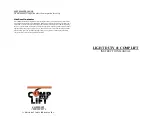
4 - 4
DPL-25S • DPL-30S • DPL-35S Super Series
Part No. 40462
September 2016
Section 4 - Scheduled Maintenance Procedures
TABLE
A
PROCEDURES
A-7
Inspect the Battery and Battery
Charger - DC Models
Proper battery and charger condition is essential to
good machine performance and operational safety.
Improper fluid levels or damaged cables and
connections can result in component damage and
hazardous conditions.
Batteries contain acid. Avoid
spilling or contacting battery acid.
Neutralize battery acid spills with
baking soda and water.
1 Put on protective clothing and eye wear.
2 Slide open the battery cover to access the
charger and the battery. The cover must remain
open for the entire charging cycle.
3 Be sure that the battery cable connections are
tight and free of corrosion.
4 Check the battery acid level. If needed,
replenish with distilled water to the bottom of
the battery fill tube. Do not overfill.
5 Install the vent caps.
6 Connect the battery charger to a grounded
outlet of proper voltage and amperage as
indicated on battery charger.
7 Set timer based on the amount of use:
Light Use—less than 15 lifting cycles: Set to 7
hours.
Heavy Use—greater than 15 lifting cycles: Set
to the
ON
position.
8 The charger will automatically shut off at the
end of the set period.
Note: If ammeter drops to 3A or less within the first
15 minutes, the battery is fully charged.
9 Check the battery acid level when the charge
cycle is complete. Replenish with distilled
water to the bottom of the fill tube.
A-8
Inspect the Columns for Damage
Detection of damage to columns is essential for
safe machine operation. An unsafe working
condition exists if the columns are damaged and
do not operate smoothly, free of hesitation and
binding. A daily check of the columns allows the
inspector to identify changes in the operating
condition of the column assemblies that might
indicate damage.
1 Visually inspect each column on each mast for
the following:
• Dents, gouges or abrasions
• Bends or warping
• Excessive wear
2 Raise and lower the platform through a complete
cycle.
Result: Platform should raise and lower
smoothly, free of hesitation and binding.
A-9
Check the Sequencing Cables
Detection of damage to sequencing cables or
components is essential for safe machine
operation. An unsafe working condition exists if the
sequencing components are damaged and do not
operate smoothly. A daily check of the sequencing
system allows the inspector to identify changes in
the operating condition that might indicate damage.
















































